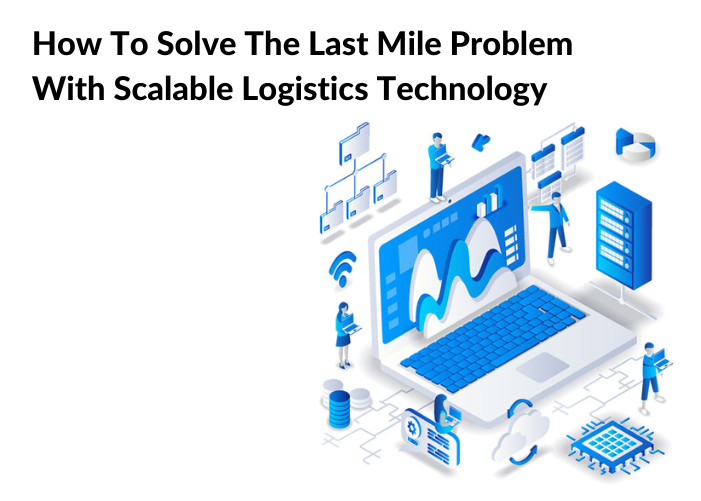Summary
The logistics and distribution industry has grown rapidly in recent years, with booming e-commerce being a key driver. However, logistics companies have also needed to adopt new technologies like scalable logistics technologies to match the rapidly increasing business growth and complex requirements of their client companies.
I. Why is scalable logistics technology for last-mile so important?
One only has to look around to realize how rapidly the logistics and distribution industries have grown in recent years. Spurred by the advent of eCommerce and the multitude of choices that it offers consumers from the convenience of their homes, the global retail industry has grown exponentially.
This has meant that the Logistics and Distribution industry – the ones that deliver packages to customers’ homes – has also grown. However, with every opportunity comes challenges and they have had to pay special heed to their operations. Within this, the last-mile delivery is of utmost importance. So much so, that customer preference for choosing an online shopping destination over another is often – and, increasingly – based on the efficiency and cost of its fulfillment!
While a lot of companies have discovered ways of efficiently fulfilling customer orders by running an efficient last-mile operation, there are numerous companies that still struggle. And, this struggle increases manifold as the companies begin to scale their operations.
With Ecommerce growth not showing signs of slowing down anytime soon, it is ever more important for companies to get their last-mile act together. Increasingly, this has meant putting in place modern, automated systems that can match the requirements of scale-up.
~ Studies show that 93% of consumers want to be kept updated in real-time during the entire delivery process, right from their package leaving the warehouse till it arrives at their address ~
II. What are some leading challenges in scaling last-mile logistics?
As experts will often tell you, the scaling-up phase of company growth is the trickiest phase to maneuver. This phase doesn’t have the nimbleness of a startup nor the solidity and resources of an established business. The challenges are many, and its solutions are forever evolving and under pressure. Common challenges of the scale-up stage include:
- Increasing volumes of orders, resources under constant pressure
- Widening consumer base with myriad and rapidly changing preferences
- Need for 100% transparency and visibility across the entire last-mile operation
- Unpredictability of operations e.g. while fleet vehicles are in transit
- High operating costs for last-mile
III. Solving the last-mile problem with scalable logistics technology
The complexity and scale of modern-day logistics and distribution networks necessitate the automation of delivery operations. This is the first step in achieving an efficient last-mile delivery operation. This optimizes the effort, resources, and time required across all processes.
Selecting the correct logistics technology solution helps in route planning, real-time tracking, customer communication, delivery dispatch, data collection, and analysis, measuring actual performance vs. planned, etc. Fleet managers can monitor this from a centralized dashboard via cloud technology. This helps in making timely and informed decisions. In a nutshell, such a solution gives you all the tools required to scale your business successfully.
Let’s look at the top 4 ways to do so:
1. Route Optimization: A driving reason why last-mile delivery is the most expensive leg of the entire supply-chain network is that it is extremely difficult to find the shortest routes between so many stops. Inefficiencies here would mean that fleet vehicles end up covering much greater distances than they otherwise could have. This affects the cost of operations and the time taken to complete deliveries.
This is where smart logistics technology is immensely helpful. It identifies the most optimal route between two points – and, the most efficient route across a delivery route with all its stops – by taking into account several variables such as traffic patterns, weather, type of cargo and vehicle, consumer delivery windows (etc.). Remember, the most efficient route doesn’t mean the shortest or the fastest, but one that balances out all the variables.
This helps Fleet Managers optimize their available resources to achieve the most efficient delivery times and meet consumer demands as best possible.
2. Live customer-updates: Customer preferences are always evolving. However, it has experienced a significant shift in modern times, what with e-commerce giants like Amazon and Walmart pampering them with superfast deliveries, often, at no cost!
Therefore, they demand more from their brands now – not only do they want fast and reliable shipping at affordable rates but they also want numerous options for shipping methods, times, and delivery windows. Importantly, they also want to be kept in the loop in real-time about the progress of their parcels. All this is easily achieved by a last-mile logistics software.
3. Live-tracking: One of the biggest improvements of modern-day automated software over legacy versions is that fleet, cargo, and driver movement can be tracked in real-time.
Fleet managers track drivers/vehicles using GPS-enabled technology on a map. They have live information about their cargo pick-up, progress, customer delivery, and order-closure procedures.
This is an invaluable feature in scalable technology. Not only can you figure out whether your original assumptions/projections are working properly, but if not, you can study the deviations in real-time to come up with more effective plans for the future.
4. Cloud-technology: Well, to make a long story short, without using a logistics solution that is centered on cloud technology, it really will be impossible for a company to scale up their last-mile solutions.
The old days of using on-site server-based technology are a thing of the past. To begin with, an on-site server system will need several more physical on-site servers across all your touch-points to create a connected network/system.
A cloud-based logistics system sits on a cloud that is easily accessed by teams from all over the globe. All data captured is uploaded in real-time and processed per the requirements of the client’s process and operations. Not only is this more efficient, but it is also much more cost-effective. It is also easy to ramp up usage (e.g. server space, number of transactions required) as your business scales up. Logistic firms can control thousands of fleet vehicles, drivers, and teams from across the world via a centralized server.
5. Data-analytics: By logical extension of the point above, a cloud-based logistics solution has the capability to perform millions of transactions using advanced data-analytics technologies such as AL and ML. The deep insight generated enables fleet managers to make informed decisions.
Conclusion: As is evident, using scalable logistics technology like a modern, automated last mile delivery software is not optional anymore. However, choosing the correct solution will enable companies to thrive as they go through the process of scaling up.




